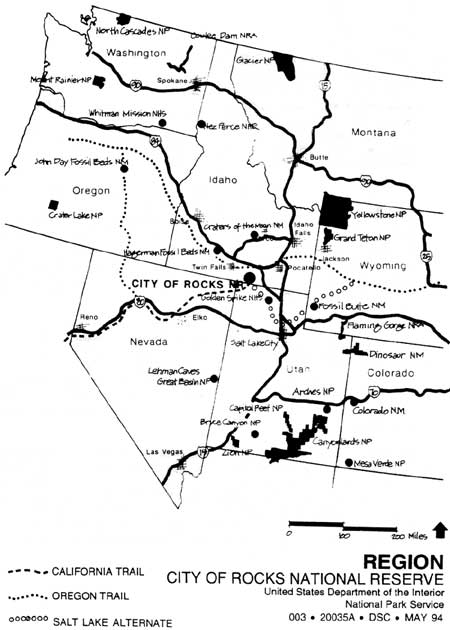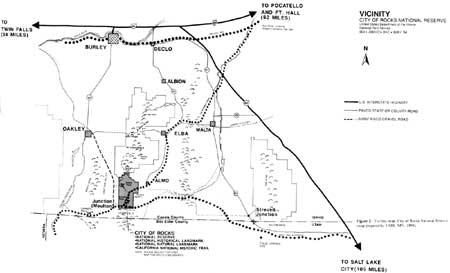|
City of Rocks
Historic Resources Study |

|
NATURAL HISTORY OF THE CITY OF ROCKS
Erosional forms . . . carved in granite . . . [are] enclosed in a large basin . . entirely hidden from view on the west and partly hidden from the east... [The basin] is the site of a maze of weirdly carved forms scattered aimlessly about the basin . . . Their distribution is not uniform, but resembles scattered villages or hamlets with more widely scattered forms between. [7]
The City of Rocks National Reserve is located in southcentral Idaho, 30 miles south of the Snake River Canyon and 2 miles north of the Utah border (Figures 1 and 2). It lies within the southern end of the Albion Mountains, and is characterized by extreme topographic relief. Steep, heavily dissected, north/south-oriented ridges and free-standing knobs typify the area. Drainages are steep, rocky, and, for the most part, ephemeral. The summit of Graham Peak (elev. 8857'), located at the north end of the reserve, is the highest point within the reserve. Intermittent Graham Creek flows across the northeast corner of the reserve, to the Almo Valley. The west slope of Smoky Mountain (elev. 7520'), a large, free-standing erosional form, dominates the east boundary, and the Cedar Hills are located adjacent to the southern boundary.
From north to south, the reserve contains two, relatively large, gently sloping, basins — each drained by an eastward flowing tributary of the Raft River. Beginning at the north end of the reserve, the Circle Creek basin draws water from three tributaries, North, Center, and South creeks. This basin contains a large concentration of granitic outcrops and monoliths that inspired the name of City of Rocks. It also contains one of the most reliable water sources within the reserve, was a favored campsite location for emigrants on the California Trail, and was the location of the earliest homestead withdrawal in the area.
The second, unnamed basin is located slightly southwest of Circle Creek — separated from the latter by a wide, low, ridge. This wide basin (incorporating about 600 acres of gently sloping land) is drained by several intermittent water courses, which join to form a single channel that flows through Heath Canyon at the base of the south side of Smoky Mountain. The moderate slope of the land, coupled with comparatively deep loamy soil, proved attractive to the dryland farmers — the settlers during the historical period. At one time this basin contained four homesites (on Enlarged Homestead claims), and various irrigation improvements (associated with a Desert Land entry).

|
| Figure 1. Region map, City of Rocks National Reserve (map prepared by USDI National Park Service, 1994). (click on image for an enlargement in a new window) |

|
| Figure 2. Vicinity map, City of Rocks National Reserve (map prepared by USDI, NPS, 1994). (click on image for an enlargement in a new window) |
The Twin Sisters, a free-standing granite formation (known as a bornhardt) that figures prominently in emigrant diaries, stands at the southern edge of this second basin (Figure 3). The tallest twin (6838') rises 750 feet above the basin floor. This formation is located midway along a narrow eroded ridge that extends southeast from the mountain that forms the west boundary of the basin. A series of smaller monoliths outcrop along the eastern toeslope of this mountain, forming an arc that rims the west edge of the basin floor. Pinnacle Pass, lying one-half mile southeast of the Twin Sisters in the same ridge system, funneled California Trail travelers into the next drainage south — out of the City of Rocks and towards the junction of the California Trail and the Salt Lake Alternate. Emery Canyon, flowing west from the crest of the Albion Mountains, provides a northwest entrance to the City.
Utah juniper, mountain mahogany, Limber pine, piñon pine, and aspen grow "promiscuously" on the low grass- and sage-covered foothills surrounding and encompassing the City of Rocks. The aspen, found along streams and hidden springs, serve as neon signs to water. Piñon pine provided American Indians with a critical food source; Limber pine, juniper, and mahogany provided Euroamerican settlers with sources of fuel and fence posts. At approximately 6,200 feet, Douglas fir, lodgepole pine, and alpine fir grow along the north and east slopes of the mountains. The farmers and ranchers of Cassia County depended upon this forest for building and fence construction and maintenance material and for employment during the fallow fall and winter months. [8]
Once interspersed with abundant bunch grass, black or big sage (Artemesia tridenta) is now the dominant vegetation in lower elevations of the reserve and on adjacent United States Forest Service (USFS) and Bureau of Land Management (BLM) range land. Crested wheatgrass, seeded during range improvement projects initiated in the 1950s, provides much of the stock feed. With the exception of natural meadows along the creek bottoms, the range is "fairly steep ..., [with] lots of surface rock." Historically, it supported livestock from late April until November, with the high elevation extremes greening by mid-May. [9]

|
| Figure 3. View of Twin Sisters from Kelton Road, 1943 (Idaho State Historical Society photograph). |
The City of Rocks, at the center of the semi-arid West, has an average precipitation of under eleven inches, three less than the minimum needed for profitable dryland farming. Much of this precipitation falls as snow during the winter season that extends from October until April. The growing season in the lowland valleys averages a scant 140 days; in the uplands the season is even shorter, initiated by late June and terminated by the frequent hard freezes of late September. [10]
The Mormon farming and ranching communities of Oakley, Elba, Almo, and Junction Valley surround the city. Oakley is 17 miles distant and is accessed along a dirt road through the City of Rocks and Emery Canyon, or by leaving the city by the south gate at the Twin Sisters, and circling the west flank of the Albion Mountains along Birch Creek. Elba and Almo are located eight miles north and three miles east, respectively, of the City of Rocks, in the substantial Raft River Valley. A rough road running along the north slope of Mount Independence connects Oakley and Elba. "Junction Valley" describes the scattered ranches (once punctuated by the towns of Moulton and of Lynn) southwest of the City of Rocks and across the Idaho border to northern Utah. The general alignment of the California Trail, now a county road, connects Junction Valley with the City of Rocks.
| <<< Previous | <<< Contents >>> | Next >>> |
ciro/hrs/sec1.htm
Last Updated: 12-Jul-2004